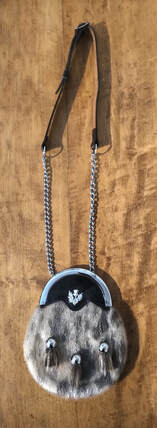|
Before the 17th century, highlanders could be seen wearing a 'feile-breacon'. This garment was a length of cloth that wrapped around the waist and draped over the left shoulder. As time went on, this garb evolved into two separate pieces called the kilt and plaid. The woven wool of the skirt-like kilt was permanently pleated in sections and the plaid was a rectangular length of cloth worn over the shoulder. A brooch would be used to secure the plaid at the shoulder. Scottish regiments wore highland dress in the British Army as recently as WW II. The cross-checked, repeating pattern of the tartan became a way to identify and distinguish between clans. In 1746, wearing tartans and playing bagpipes was banned. It would be fifty years before the law was repealed and the tartans and bagpipes were seen and heard again. Swords would be held in a crossbelt. The sword was regarded as a symbol of honour of a highlander. The sporran was traditionally a leather pouch that could be used to carry a daily ration of oatmeal for a highlander. The sporran is sometimes adorned with horsehair, tassels and an ornamental ‘cantle’ at the top. The ensemble worn in the traditional Scottish dress has many components. Accessories include brogues as footwear, the sporran worn on a chain around the waist, the crossbelt, collar dogs, pins, hackles and hats. Traditionally, an ostrich feather bonnet was worn until about World War II. Now these impressive hats are worn by pipers and drummers in ceremonial events. A ‘Glengarry’ hat is adorned with an eagle feather or plume called a ‘hackle’.
0 Comments
Leave a Reply. |
AuthorThis journal is written, researched, and maintained by the volunteers of the Middleville Museum. |







